1—
At the heart of those traditions is what Aldous Huxley calls "preternatural light," by which he means a special luminosity of objects seen during a visionary experience. Huxley describes and explores the implications of preternatural light in Heaven and Hell , his sequel to the better-known Doors of Perception .[4] Whereas the latter concentrates on Huxley's own experiences under the influence of mescaline, Heaven and Hell transposes his personal experience to cultural and historical levels. Drawing his evidence from reports of experiments with sensory deprivation and hallucinogenic drugs, as well as from the testimony of seers, mystics, poets, and visual artists, Huxley makes a comparative study of visionary experiences and finds that such experiences have certain visual features in common. Since the same visual features appear in Anger's films, I propose to approach Anger's treatment of light by way of Huxley's account of the visionary experience.
"First and most important," Huxley writes, "is the experience of light. Everything seen by those who visit the mind's antipodes is brilliantly illuminated and seems to shine from within" (75). In the writings of visionaries, Huxley notes, this "preternatural light" is commonly expressed through references to gemstones, pearls, gold and silver, crystal and glass; in other words, to those materials in our normal, nonvisionary world that are most luminescent, most intensely glowing with color, and therefore most like the "self-luminous objects" seen by the visionary. As a characteristic example, Huxley quotes from the Hindu Ramayana : "The country all around is covered by jewels and precious stones, with gay beds of blue lotus, golden-petalled. Instead of sand, pearls, gems, and gold form the banks of the rivers, which are overhung with trees of fire-bright gold" (83). A Biblical counterpart to this vision of the Other World is found in the Book of Ezekiel: "Thou has been in Eden, the garden of God. Every precious stone was thy covering, the sardius, topaz and the diamond, the beryl, the onyx and the jasper, the sapphire, the emerald and the carbuncle, and gold. . . . Thou hast walked up and down in the midst of the stones of fire" (84). On the evidence of passages such as these Huxley concludes that "precious stones are precious because they bear a faint resemblance to the glowing marvels seen with the inner eye of the visionary" (86).
Furthermore, Huxley argues, "Whatever, in nature or in a work of art, resembles one of those intensely significant, inwardly glowing objects encountered at the mind's antipodes, is capable of inducing, if only in a partial and attenuated form, the visionary experience" (87). Hence the gleaming altars and glowing stained-glass windows in the cavernous gloom of medieval cathedrals; hence the gold and silver, the bejewelled and pearl-encrusted art and artifacts at shrines throughout the world. "Polished metals and precious stones are so intrinsically transporting," says Huxley, "that even a Victorian, even an Art Nouveau jewel is a thing of power. And when to this natural magic of glinting metal and self-luminous stone is added the other magic of noble forms and colours artfully blended, we find ourselves in the presence of a genuine talisman" (88).
Kenneth Anger, who once remarked that filmmaking "is like making a painting out of real gold and jewels," creates cinematic equivalents of the "talismans" Huxley so eloquently describes.[5] The basis of that equivalence is light: light with the gemlike intensity of a visionary experience.
Anger's most literal association of light with the vision-inducing power of precious stones and metals appears in the opening sequence of Inauguration of the Pleasure Dome (1954, revised 1960, 1966, 1978). From a
glowing horizon, soft beads of light climb slowly upward. Then, as the focus sharpens, the lights are revealed to be a string of diamondlike gems rising from the floor to a bed. Supine on the bed, Lord Shiva (as Anger identifies his protagonist) slowly wraps the string of gems around his hand. After langorously selecting several sumptuous rings from his bedside table and slipping them on his fingers, he lowers the dangling gems into his mouth and swallows them.
This strange opening is echoed three times in the film. Lord Shiva subsequently swallows a large crystal pendant, a pearl, and a gold-link snake—gifts ceremoniously presented to him by his guests. In his description of the film, Anger identified each gift as a "talisman," which calls to mind Huxley's description of a Victorian or Art Nouveau jewel as a "genuine talisman." For Anger, as for Huxley, the source of this talismanic power is light. The softly focused opening of Inauguration of the Pleasure Dome makes the gems look like a string of small lights. By sharpening the focus as the shot continues, Anger cinematically transforms the lights into precious stones. Although he hardly belabors the point, Anger has opened his film by demonstrating the source of the gem's potency (in terms that Huxley's discussion makes even clearer) and has provided a clue to the symbolic significance of swallowing the string of gems, the crystal pendant, the pearl, and the gold snake. In material forms resembling the "self-luminous objects" of the visionary experience, Lord Shiva is ritually ingesting light itself.
These rituals suggest a Eucharistic ceremony, and in a headnote to one of his descriptions of the film, Anger quotes Aleister Crowley:
A Eucharist of some sort should most assuredly be consumed daily by every magician, and he should regard it as the main sustenance of his magical life. It is of more importance than any other magical ceremony, because it is a complete circle. The whole of the force expended is completely re-absorbed; yet the virtue is that vast gain represented by the abyss between Man and God. The magician becomes filled with God, fed upon God, intoxicated with God. Little by little his body will become purified by the internal lustration of God.[6]
Through this association of the jewels with the Eucharist, Anger implies that it is not enough to possess and contemplate these "talismans" of light. They must be consumed if their vision-inducing power is to be realized. Then Lord Shiva may be "purified by the internal lustration of God."[7]
Anger intended the film as a whole to have a comparable Eucharistic effect on the audience. In an interview published in 1967 he describes his
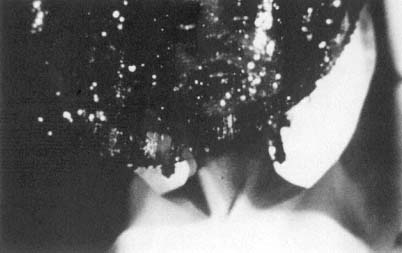
Donning a sequined black dress in Puce Moment .
goal: "[I] wanted to create a feeling of being carried into a world of wonder. And the use of color and phantasy is progressive; in other words, it expands, it becomes completely subjective—like when people take communion; and one sees it through their eyes."[8] The effect is "progressive" in the sense that the frenetic rhythms and multiple superimpositions of the film's hallucinatory climax represent the cumulative "subjective" effect of the lush colors; the exotic costumes; the Beardsleyesque jewelry, draperies, and candles; and the somnolent movements and ritualized gestures of the hieratic characters in the first two-thirds of the film.
If Lord Shiva's ingestion of gems suggest that preternatural light may be taken internally, so to speak, then there is evidence in other films that it may be administered externally as well. It may be put on the body and worn, like the rings Lord Shiva puts on before swallowing the string of gems or the three large silver rings the protagonist of Scorpio Rising (1963) chooses for himself before going to the motorcyclists' party. Other motorcyclists cover themselves with vision-inducing ornaments, as Anger memorably records in the "Blue Velvet" sequence of Scorpio Rising —a sequence that may be more fully appreciated if we first examine the dressing scene in Anger's early film fragment Puce Moment (1949).
That film begins with a parade of elaborately sequined dresses. As each dress is held up to the camera, it passes in and out of focus, and as it does so its sequins turn into dancing dots of light against colored backgrounds.
The effect is most striking when the last dress appears: a black gown whose sequins flicker and gleam like a myriad of stars in a black sky. This is the dress the film's heroine puts on. She raises her arms above her head and laughs ecstatically as the dress descends, enveloping her in a sheath of glittering lights. To don the dress is to enjoy a "transporting" experience—as the pop songs on the sound track clearly announce: "My mind will listen to the stars . . . my mind is in the air," and, "Yes, I am a hermit, my mind is not the same. Yes, I am a hermit, and ecstasy is my game." Parts of Puce Moment appear in the superimposed material at the climax of Inauguration of the Pleasure Dome , which further suggests that the dresses are "talismans" of "preternatural light."
In Scorpio Rising the clothes of the motorcyclists take on a similarly visionary significance. Against black leather and blue jeans, the silver studs, chains, buckles, amulets, and trinkets shine with exceptional brilliance, and in some shots they flash their reflected light directly into the eyes of the audience. During this "dressing adagio," as Anger has called it,[9] camera movement and montage supported by Bobby Vinton's sinuous rendition of "Blue Velvet" meld the slow, studied gestures of the men into a continuous flow. The result is a mood that rises above mere sensuality and self-indulgence. It suggests reverence for these light-bearing garments.
The same mood and movement accompanies Anger's presentation of the objects most radiant with "the natural magic of glinting metal": the motorcycles themselves. A chain becomes linked lights in velvety darkness. The rounded edge of a gas tank reflects brilliant rays of light. The bars, tubes, and cylinders of polished chrome gleam like intricate jewelry. In the nighttime streets, the motorcycles not only glitter with reflected light but shine their headlights directly into the camera and, therefore, into the viewer's eyes.
"I see the lights! I see the party lights!" sings Claudine Clark as Anger introduces a close-up of a motorcycle's front wheel with blinking lights entwined in its spokes. Decorated like a sacred effigy, the motorcycle presides over the rowdy gathering that Anger calls a "cycler's Sabbath" and a "Walpurgis Party."[10] It is also—though the participants may not be conscious of it—a celebration of the motorcycle as a "light-bringer." Appropriately, "I see the lights!" resonates with religious and mystical implications. Anger is a master at evoking unexpected meanings from the seemingly banal lyrics of popular songs, and in this case he implies that those watching the film should be able to "see the lights" as well. In fact, the audience has been seeing them since the film began. Throughout
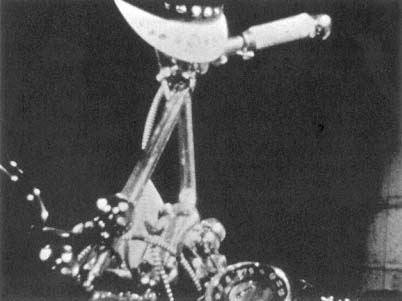
The motorcycle as talisman in Scorpio Rising .
Scorpio Rising , the motorcycle is shown to be a "genuine talisman" and "a thing of power," not because of its size, noise, or horsepower, nor because of its popular association with speed, gangs, and violence, but because of the gleaming luster with which it hints at "the glowing marvels seen with the inner eye of the visionary."
If Scorpio Rising hints at the supernatural power in gleaming metal, Kustom Kar Kommandos (1964) dwells on it. If preternatural light is glimpsed against the darkness of deep-shadowed garages, black leather, and night in Scorpio Rising , it boldly and steadily shines forth in Kustom Kar Kommandos . If parts of the motorcycles are sometimes jewel-like, the customized car is itself a single, complete jewel. It is placed on display in a clean, well-lighted room and attended by a blond young man in pristine blue who worshipfully dusts it with a feathery white puff. Then he climbs inside, encasing himself in an interior of polished chrome and red leather seats. While the whispery voices of the Parris Sisters sing about a "dream lover" and their longing to "know the magic of his charms," Anger's gliding camera movements and smoothly articulated montage turn the car's polished surfaces into silvery streams of light, leaving no doubt that the car is a "dream lover" and a magical "charm."
In Heaven and Hell Huxley complains that modern technology, advertising, and the mass distribution of manufactured goods have made intense light, gleaming surfaces, and brilliant colors so commonplace that they have lost their visionary power. Our sensibilities have been dulled by the omnipresence of glass, chrome, stainless steel: "Metal surfaces wink at us in the bathroom, shine from the kitchen sink, go glittering across the country in cars and trains. . . . What was once a needle of visionary delight has now become a piece of disregarded linoleum." (95) But Anger understands that even the products of modern technology can be transformed into vessels of preternatural light. By carefully capturing their brilliant flashes of reflected light, Anger turns them into visual equivalents of precious stones and metals. Then, to make the "precious" become "preternatural," he gives the light a life of its own, and while the viewer's attention is drawn to the sensuous beauty of sequined dresses, studded black leather, and chromium motor parts, the light they emit reaches "the antipodes of the mind," in Huxley's phrase, where all experience is visionary.
The work that most completely exemplifies this process is Eaux d'artifice (1953). Here water is the principal medium for preternatural light, and a "Water Witch" (Anger's designation) is its personification. The film's blue tinting turns every shadowed area into a rich, dark blue "setting" for the gemlike light reflecting off the water and the sequins in the Water Witch's gown. In effect, the tinting turns the strip of film into a blue stream from (or through) whose surface preternatural light gleams and flashes into viewers' eyes as they follow the mysterious bright figure who emerges from the plumed jet of a fountain at the beginning of the film, journeys through the glittering garden, and returns to the down-flowing watery light at the end. Anger's editing reinforces the water-light metaphor by joining most of the shots with dissolves that carry one image into the next like water flowing over shiny stones.
"Pour water on thyself: thus shalt thou be a Fountain to the Universe. Find thou thyself in every Star! Achieve thou every possibility!" Taken from the writings of Crowley, that is the epigraph for Anger's notes on Eaux d'artifice .[11] The film pours light on its viewers, so that they may find a "Star" in themselves. The visionary quality of light in the film is nicely captured in the Homeric term "splendor," which, as Michael Bernstein points out, "is one of the standard Homeric epithets appropriate to water, especially when the reference is to a scared fountain or temple district." As an example Bernstein quotes from the Iliad (II, 307): "whence did flow splendid water."[12]
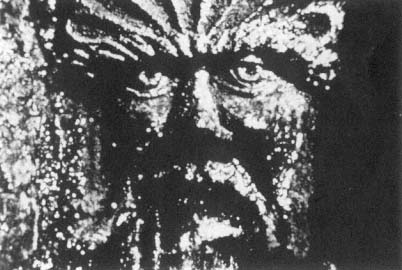
"Splendid water" glazes a stone face in Eaux d'Artifice .
Although the brief flash of chartreuse light emitted by the Water Witch's fan might seem to be the "Lucifer moment" of the film, I would argue that there are many and more splendid moments provided by the water itself. Fountains, pools, streams, and falls glitter in the deep blue shadows of the garden, and even stone steps and carved faces gleam as the "splendid water" glazes them with liquified light. In one particularly elegant sequence, slow motion transforms thin sprays of water into streaks and beads of light that glitter like gems strung across the deep blue darkness. It is a triple transformation: from water to light to gems. These gems could, indeed, be swallowed by Lord Shiva, but they are consumed by the viewer's eyes instead.
Similar images appear in close-ups of the motorcycles in Scorpio Rising , the customized car in Kustom Kar Kommandos , and the black-sequined dress in Puce Moment . The flow of light in Scorpio Rising and Kustom Kar Kommandos follows the intricate structure of mechanical parts. In Eaux d'artifice and Puce Moment the light is less tightly patterned, but in every case the flickers and gleams shine out against a blue-black background—not like immaterial, abstract designs, but like patterns of energy shimmering with a peculiar, mercurial solidity. They are the purest and most autonomous expressions of preternatural light in Anger's films.
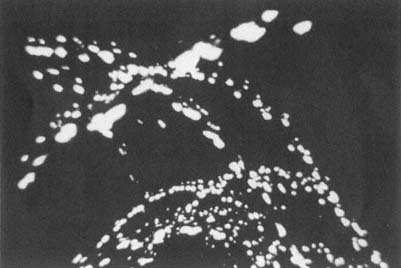
Slow motion transforms a fountain's spray into
beads and streaks of light in Eaux d'artifice .

A motorcycle glows in the dark in Scorpio Rising .
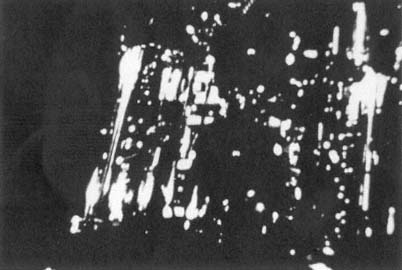
Preternatural light gleams from the polished
engine of a customized car in Kustom Kar Kommandos .